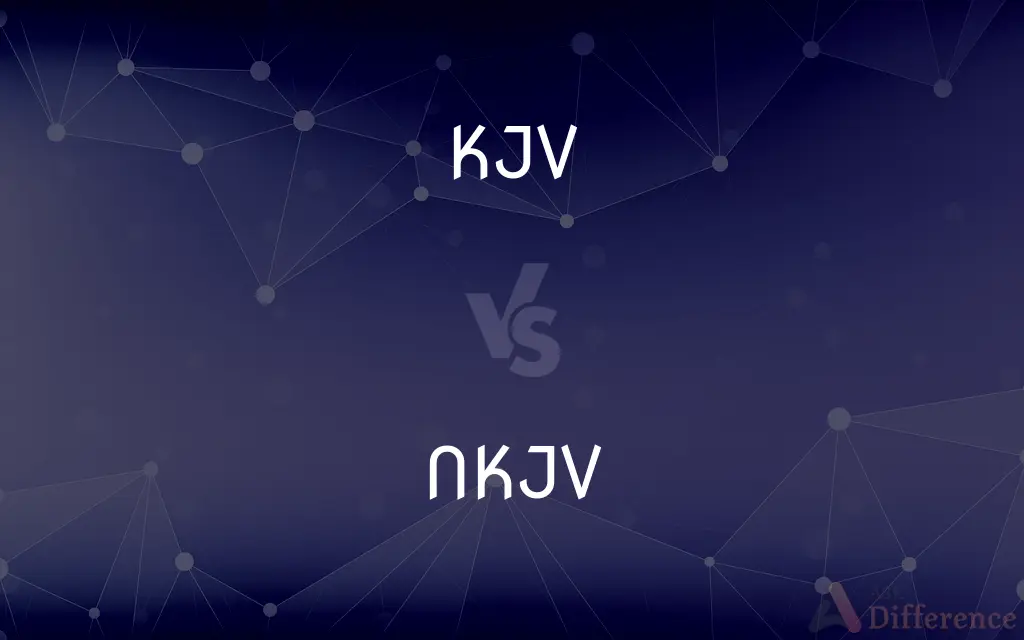KJV vs. NKJV — What's the Difference?
By Tayyaba Rehman — Published on January 24, 2024
KJV (King James Version) is a classic English translation of the Bible from 1611, while NKJV (New King James Version) is a modern version from 1982, retaining the style of KJV but with contemporary language.

Difference Between KJV and NKJV
Table of Contents
ADVERTISEMENT
Key Differences
The King James Version (KJV), completed in 1611, is a historic English translation of the Bible, known for its majestic style and poetic rhythm. The New King James Version (NKJV), published in 1982, updates the archaic language of the KJV while maintaining its classic style.
KJV uses early 17th-century English, including words like "thee" and "thou," making it challenging for modern readers. NKJV, in contrast, employs contemporary English, replacing outdated terms to enhance readability without losing the original text's essence.
The KJV was translated using earlier manuscripts available at the time, reflecting the scholarship of that era. NKJV benefits from advances in biblical scholarship and more recent manuscripts, aiming for both linguistic accuracy and clarity.
KJV's influence extends beyond religion into literature and language, often cited for its literary beauty. NKJV seeks to preserve this literary quality while making the text more accessible and understandable to a 20th-century audience.
KJV remains a popular choice for its literary and historical significance, despite its archaic language. NKJV offers an alternative for those who appreciate the traditional KJV but desire a version that aligns more closely with contemporary language and understanding.
ADVERTISEMENT
Comparison Chart
Publication Year
1611
1982
Language Style
Early 17th-century English
Contemporary English
Target Audience
Traditionalists, literary enthusiasts
Modern readers seeking traditional style
Basis of Translation
Earlier manuscripts of the era
Advanced biblical scholarship and manuscripts
Readability
Challenging due to archaic language
Easier for modern readers
Compare with Definitions
KJV
Archaic Language: Uses early modern English, like "thee" and "thou."
Thou shalt not steal is a well-known commandment from the KJV.
NKJV
Faithful to Original: Maintains the stylistic essence of the KJV.
The NKJV preserves the poetic rhythm of the KJV while updating the language.
KJV
Literary Style: Known for its poetic and majestic language.
The Psalms in the KJV are often praised for their poetic beauty.
NKJV
Scholarly Revised: Reflects more recent biblical scholarship.
The NKJV includes footnotes and references based on newer manuscript discoveries.
KJV
Influential Text: Has significantly influenced English language and literature.
Many common phrases in English originated from the KJV.
NKJV
Accessible and Understandable: Aims to be clear for modern readers.
The NKJV is preferred by those who enjoy the KJV but want clearer language.
KJV
Religious and Cultural Significance: Revered in many Christian denominations.
The KJV is often used in traditional Christian worship services.
NKJV
Modern Bible Translation: Updated version of the KJV from 1982.
The NKJV makes the original text of the KJV more accessible to today's readers.
KJV
Historic Bible Translation: English translation from 1611.
The KJV has been a cornerstone of English literature for centuries.
NKJV
Contemporary Language: Replaces archaic terms with modern equivalents.
The NKJV updates phrases like thou shalt to you shall.
Common Curiosities
When was the KJV published?
The KJV was published in 1611.
When was the NKJV published?
The NKJV was published in 1982.
What does KJV stand for?
KJV stands for King James Version, a historic Bible translation.
What does NKJV stand for?
NKJV stands for New King James Version, a modern update of the KJV.
What is the main difference in language between KJV and NKJV?
KJV uses early modern English, while NKJV uses contemporary English.
Are there doctrinal differences between KJV and NKJV?
The core doctrines remain the same, though there are slight textual differences due to updated scholarship.
Is the poetry of the Psalms preserved in the NKJV?
Yes, the poetic quality of the Psalms is preserved in the NKJV.
Is the NKJV easier to read than the KJV?
Yes, the NKJV is generally easier for modern readers due to its contemporary language.
Can I find the "thee" and "thou" language in NKJV?
No, the NKJV replaces archaic terms like "thee" and "thou" with contemporary language.
Does the NKJV maintain the literary style of the KJV?
Yes, the NKJV preserves the stylistic essence of the KJV while updating the language.
Why is the KJV still popular?
The KJV is popular for its literary beauty and historical significance.
Is the NKJV suitable for daily reading?
Yes, the NKJV is suitable for daily reading, especially for those who prefer modern English.
What kind of footnotes does the NKJV include?
The NKJV includes footnotes that offer translation notes and updated scholarly references.
Which version should a new Bible reader start with, KJV or NKJV?
A new Bible reader might find the NKJV more accessible due to its contemporary language.
Which version is better for academic study, KJV or NKJV?
For academic study, the NKJV might be preferable due to its updated scholarship and readability.
Share Your Discovery

Previous Comparison
AKC vs. CKC
Next Comparison
Dremel vs. Die GrinderAuthor Spotlight
Written by
Tayyaba RehmanTayyaba Rehman is a distinguished writer, currently serving as a primary contributor to askdifference.com. As a researcher in semantics and etymology, Tayyaba's passion for the complexity of languages and their distinctions has found a perfect home on the platform. Tayyaba delves into the intricacies of language, distinguishing between commonly confused words and phrases, thereby providing clarity for readers worldwide.
















































